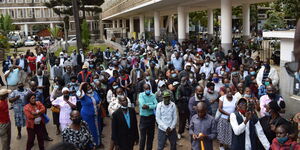A single letter, declassified in 2012, lay bare torture methods that the British colonialists had decided to adopt after a massive outcry and increased attention from the international community over the methods earlier used.
British tabloid The Guardian was first to report on 18 April, 2012, that in June 1957, Eric Griffith-Jones, the attorney general of the British administration in Kenya, wrote to the governor of Kenya Sir Evelyn Baring (1952-1959) detailing the way the regime of torture at the colony's detention camps was being subtly altered.
"From now on, for the torture to remain legal, Mau Mau suspects must be beaten mainly on their upper body. Vulnerable parts of the body should not be struck, particularly the spleen, liver or kidneys," Griffith wrote.
Aware of the tough stance the British leadership had on the Mau Mau, Griffith, with a view to sweetening the deal, maintained that he still had the best people on the job to ensure that the British got the information they wanted.
"It is also important that those who administer the interrogation methods should remain collected, balanced and dispassionate", the letter stated.
The letter was received by Baring, who was in complete support of Griffith's new methods, and also aware of the international attention that the methods used in Kenya were attracting.
"The new resolutions must remain secret. If we are going to sin, we must sin quietly," reads the reply from Baring urging caution.
Before the letter intimating the changes, the methods used to extract information from the Mau Mau went beyond the line, even to some of the settlers who were in favor of the torture of the Mau Mau.
"We knew the slow method of torture was worse than anything we could do. Special Branch there had a way of slowly electrocuting a Kuke (Kikuyu)—they'd rough up one for days. Once I went personally to drop off one gang member who needed special treatment. I stayed for a few hours to help the boys out, softening him up. Things got a little out of hand," a British settler described the situation in the country.
He then described the gruesome torture that they meted on the unfortunate victim, with the mutilated suspect dying before the British could extract what they wanted out of him.
The testament by the settler and further torture meted was detailed by a professor of History and African American Studies at Harvard University, Sarah Elkin, in her book Britain's Gulag: The Brutal End of Empire in Kenya.
"The screening teams whipped, shot, burned and mutilated Mau Mau suspects, ostensibly to gather intelligence for military operations and as court evidence," a part of her text reads.












